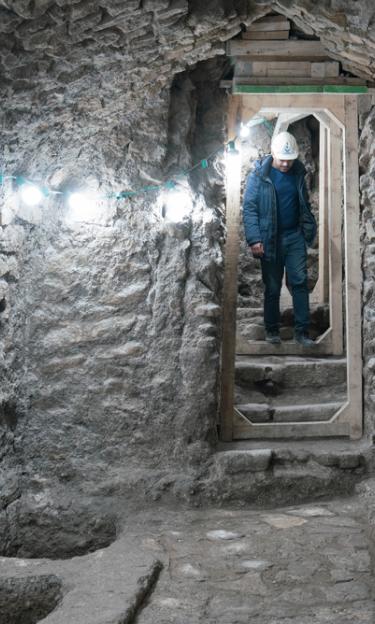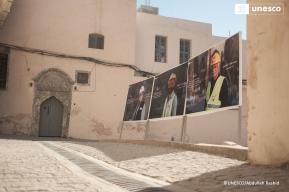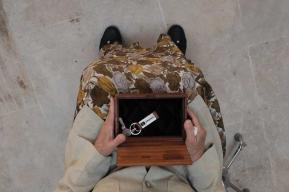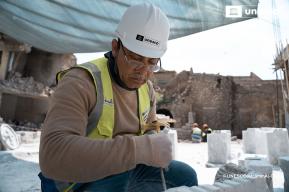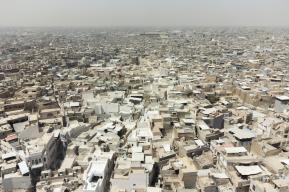Can you imagine going to work one morning and discovering something about the history of your city and your ancestors that no one knew about?
This is what happened to a team of 40 workers and archaeologists who worked on the Al-Nouri Mosque compound, being reconstructed by UNESCO in partnership with the United Arab Emirates and the government of Iraq. Al-Nouri Mosque was destroyed during the war and is being rebuilt brick by brick, bringing back hope to a war-torn city. Archeologists made a groundbreaking discovery that was buried underground, underneath the Prayer Hall of Al-Nouri Mosque, a discovery that was not recorded by history.
During the archaeological excavations, some gaps were found that led to four rooms that were used for ablution. These rooms that go back to the 12th century Atabeg era were completely buried and were not mentioned in the historical sources and books.
Some other artifacts were also discovered during the excavation including jars, pottery pieces and pieces of carved stone, in addition to coins dating back to different periods.
The reconstruction of Al-Nouri Mosque is one of the most complex and ambitious reconstruction projects in modern times. It requires many steps to ensure the safety of the site, the strengthening of the remaining structure and the safeguarding of scattered stones that can be used in the reconstruction process.
In August 2021, the time had come to study the site to ensure the safety of the foundation. An excavation process began near the prayer hall. Gradually, the workers uncovered the original floor of the mosque before its reconstruction in the forties of the last century. While working on the newly exposed part of the floor, they noticed gaps under the floor of the mosque, which led them to a room almost completely buried under the mosque.
This discovery is important for the archeological community in Iraq and shed a new light on the history of the Mosque. It highlights the deep history of the site, providing tangible evidence, along with the Al Hadba Minaret, that the complex dates back to the XII century, thereby contributing to the overall study of the history of the Old City of Mosul.
I have been following the news on the reconstruction of Al-Nouri Mosque for quite some time, not only because I care about it, but also because 4 million Moslawis are attached to it from their childhood.
I was overwhelmed with happiness when I heard about the discoveries! Having this heritage, preserved for so many years underground, having it escape the intentional destruction of heritage that the rest of the city endured, it’s a miracle. It is true that we lost a lot, but hopefully what is coming is better.
The National Commission for Heritage and Antiquities is working with UNESCO to preserve these parts and ensure it rehabilitation and preservation as a museum for visitors to learn about the different phases that the mosque went through in its construction and its 8-century history.
I wish for this site to become open to tourists so that there is more movement in the Old City, it will improve our living standards, and this City deserves to be discovered, it is full of archeological details and surprises.
More than 800 years after its construction in the middle of the Old City of Mosul in Iraq, with its beloved leaning minaret dominating the city’s skyline and overlooking the courtyards of the surrounding houses and the city’s narrow alleys, Al-Nouri Mosque and its minaret were destroyed in 2017 by conflict turning this iconic landmark to rubble leaving its people shocked and in despair.
In 2018, less than a year after the end of conflict UNESCO launched its flagship initiative to “Revive the Spirit of Mosul” and its work on the reconstruction of this important archaeological site started in partnership with the United Arab Emirates and in cooperation with the Iraqi Ministry of Culture and the Sunni Endowment. Beyond the reconstruction of heritage, this project has created jobs and enhanced social cohesion in a city destroyed by war.
Within the scope of UNESCO’s flagship initiative “Revive the Spirit of Mosul” that aims to revive a spirit of peaceful co-existence and social cohesion, through heritage, cultural life and education, the United Arab Emirates partnered with UNESCO investing US$50.4 million for the restoration and reconstruction of the historic landmarks of Mosul – Al-Nouri Mosque and Al-Hadba minaret, Al-Saa’a and Al-Tahera Churches. UNESCO works in partnership with the United Arab Emirates and in coordination with the Government of Iraq, local partners and international experts.




